Goolwa, South Australia 作者: 来源: 发布时间:2021-03-25
I. Population and Area
Total Area: 1400 km²
Population in 2011: 2, 201
https://localstats.com.au/population/sa/south/fleurieu-peninsula/goolwa
II. Natural Geography
-Climate
Average temperatures and precipitation
The "mean daily maximum" (solid red line) shows the maximum temperature of an average day for every month for Goolwa. Likewise, "mean daily minimum" (solid blue line) shows the average minimum temperature. Hot days and cold nights (dashed red and blue lines) show the average of the hottest day and coldest night of each month of the last 30 years. For vacation planning, you can expect the mean temperatures, and be prepared for hotter and colder days. Wind speeds are not displayed per default, but can be enabled at the bottom of the graph.
The precipitation chart is useful to plan for seasonal effects such as monsoon climate in India or wet season in Africa. Monthly precipitations above 150mm are mostly wet, below 30mm mostly dry. Note: Simulated precipitation amounts in tropical regions and complex terrain tend to be lower than local measurements.
Cloudy, sunny, and precipitation days
The graph shows the monthly number of sunny, partly cloudy, overcast and precipitation days. Days with less than 20% cloud cover are considered as sunny, with 20-80% cloud cover as partly cloudy and with more than 80% as overcast. While Reykjavík on Iceland has mostly cloudy days, Sossusvlei in the Namib desert is one of the sunniest places on earth.
Note: In tropical climates like in Malaysia or Indonesia the number of precipitation days may be overestimated by a factor up to 2.
Maximum temperatures
The maximum temperature diagram for Goolwa displays how many days per month reach certain temperatures. Dubai, one of the hottest cities on earth, has almost none days below 40°C in July. You can also see the cold winters in Moscow with a few days that do not even reach -10°C as daily maximum.
Precipitation amounts
The precipitation diagram for Goolwa shows on how many days per month, certain precipitation amounts are reached. In tropical and monsoon climates, the amounts may be underestimated.
Wind speed
The diagram for Goolwa shows the days per month, during which the wind reaches a certain speed. An interesting example is the Tibetan Plateau, where the monsoon creates steady strong winds from December to April, and calm winds from June to October.
Wind speed units can be changed in the preferences (top right).
Wind rose
The wind rose for Goolwa shows how many hours per year the wind blows from the indicated direction. Example SW: Wind is blowing from South-West (SW) to North-East (NE). Cape Horn, the southernmost land point of South America, has a characteristic strong west-wind, which makes crossings from East to West very difficult especially for sailing boats.
General information
Since 2007, meteoblue has been archiving weather model data. In 2014 we started to calculate weather models with historical data from 1985 onwards and generated a continuous 30-year global history with hourly weather data. The climate diagrams are the first simulated climate data-set made public on the net. Our weather history covers any place on earth at any given time regardless of availability of weather stations.
The data is derived from our global NEMS weather model at approximately 30km resolution and cannot reproduce detail local weather effects, such as heat islands, cold air flows, thunderstorms or tornadoes. For locations and events which require very high precision (such as energy generation, insurance, etc.), we offer high resolution simulations with hourly data.
https://www.meteoblue.com/en/weather/historyclimate/climatemodelled/goolwa_australia_2070667
What is the best time of year to go to Goolwa in Australia
Here are some average weather facts we collected from our historical climate data:
During the month of April, October and November you are most likely to experience good weather with pleasant average temperatures that fall between 20 degrees Celsius (68°F) and 25 degrees Celsius (77°F).
On average, the warmest month(s) are January and February.
The months of June and July have a high chance of precipitation.
The warmest month is January with an average maximum temperature of 29°C (84°F).
The coldest month is July with an average maximum temperature of 15°C (59°F).
June is the most wet month. This month should be avoided if you are not a big fan of rain.
February is the driest month.
-Geography
GOOLWA
89 kilometres from Adelaide
Australia's first Cittaslow Town, Goolwa was once a thriving river port – the last on the Murray River before it reached the Southern Ocean. Today, Goolwa offers a steam-to-steam experience with PS Oscar W, a 100 year old authentic paddle steamer, and the Cockle Train, a steam train journey.
The town still has many historical features, its present day life is as a busy regional centre with great pubs, a microbrewery, restaurants and cafés, and is a popular gateway to the Coorong National Park and the lakes system at the mouth of the Murray River.
History overlooked Goolwa for a century or so, leaving it with a subtle, unpretentious beauty and many wonderful old sandstone buildings dating back to the 1850s. The Goolwa State Heritage area surrounds the Goolwa Visitor Information Centre, which should be the starting point for any visitor wanting to learn more about the town and its many attractions, as well as its colourful river port history and the Ngarrindjeri culture of the region.
Explore the local waterways by taking a cruise on the lower Murray River on an authentic 103 year old paddle steamer or an eco-cruise into the Coorong. Australia's oldest railway, commissioned in 1854, still runs a historic passenger service between Goolwa, Middleton, Port Elliot and Victor Harbor.
Goolwa also fronts the Southern Ocean where a sand dune boardwalk provides great views and cocklers gather pipis or cockles (a mollusc) on the beach. This beach can also be reached by 4WD (take note of tide times and warning signs at Goolwa Beach) and is a popular surf spot.
FAST FACT
In it's heyday, Goolwa was the only place in Australia where paddle steamers and steam trains met to carry produce inland for shipping overseas.
https://fleurieupeninsula.com.au/goolwa
MURRAY MOUTH CRUISE
OVERVIEW
Murray Mouth Cruise
Depart Goolwa Main Wharf and cruise downstream through the lock in the Goolwa Barrage and down the final stretch of the Murray River. Cruise back past sand dunes supporting native vegetation and past abundant wetland bird life, through the Lock again and back to Goolwa. Visit the Coorong seal colony and feel the Storm Boy inspired region.
Goolwa, SA
Historic port, now a holiday town, near the mouth of the Murray River.
Goolwa, an historic port at the mouth of the Murray River, is now an upmarket holiday resort for Adelaide people. It is only an hour's drive from Adelaide's CBD. The town was declared a State Heritage Area in 1987 and consequently it has a large number of very well preserved buildings which offer a unique insight into the working of one of Australia's most significant inland ports. Goolwa is a genuinely important location which offers visitors a series of important experiences ranging from the development of the port near the mouth of the Murray; an insight into the importance of the Murray River as a transport route prior to the construction of railway lines; the unique and stable culture of the Ngarrindjeri people; and the attempts to turn this historic port into a chic holiday and weekend destination by developers with little consideration for the local Aborigines and their traditions.
Location
Goolwa is located on the shores of Lake Alexandrina, on the western section known as the Goolwa Channel, 82 km south of Adelaide.
https://www.aussietowns.com.au/town/goolwa-sa
-Transportation
Local transport in the region
Bus
Bus transport is available with Link SA from Adelaide to Mount Compass, Port Elliot, Middleton and Goolwa. Link SA also operate a bus service to Victor Harbor. Visit the Link SA website www.linksa.com.au for timetables and prices or contact the Goolwa Visitor Information Centre on phone 1300 466 592 or email goolwavic@alexandrina.sa.gov.au
Bus transport is available with Adelaide Metro from Adelaide and Mount Barker to Strathalbyn. Visit the Adelaide Metro website www.adelaidemetro.com.au for timetables, bus routes and prices or contact the Strathalbyn Visitor Information Centre on phone 1300 007 842 or email strathalbynvic@alexandrina.sa.gov.au
Car Hire
Europcar car hire is available from the Goolwa Airport just north of Goolwa. For prices and availability visit the Europcar website www.europcar.com.au
D&D Mechanical and 4WD have older model cars available for short term hire at their premises on Gardiner Street, Goolwa. For pricing and further information phone 08 8555 1182 or email ddmec4wd@bigpond.net.au
Regional Airports
Regional airports are located at Goolwa and Strathalbyn for those with their own planes. For airport specifications and facilities available refer to their websites
Goolwa www.goolwaairport.com.au
Strathalbyn www.roobyte.com.au/SDFC/index.php
https://www.visitalexandrina.com/region/transport
ACCESS BY ROAD IS LESS THAN 45 MINUTES FROM THE SOUTHERN METRO AREAS OF ADELAIDE.
The Fleurieu Peninsula is a place where small intimate villages are nestled in the folds of its hills and historic townships hug its beautiful shores, all within an easy and beautiful drive of one another.
Travel from Adelaide using the Southern Expressway, via McLaren Vale – the Gateway to the Fleurieu. Access from the Adelaide Hills using the South Eastern Freeway via Echunga to Meadows, or via Mt Barker to Strathalbyn. There are also many scenic drives through the hills by way of minor sealed roads.
Travellers from the eastern States can enter the region via a free ferry across the River Murray at Wellington. It operates 24 hours a day with only a short wait between crossings.
An interpreted touring route, the Fleurieu Way, circles the Peninsula, linking the Great Ocean Road and the Adelaide metro area to the Fleurieu. More info about our Self Drive Touring routes.
2WD AND 4WD
2WD is suitable for travelling throughout most of the region. Many beaches allow vehicle access, such as Moana, Silver Sands, Sellicks and Aldinga. For the Coorong National Park and Goolwa Beach you need a 4WD. Some sections of Deep Creek Conservation Park are also restricted to 4WD access. Check signage and conditions prior to entry.
HIRE CAR
There are hire cars available in the region – contact the local Visitor Information Centres for details. Also check with local RAA offices. Alternatively, you can pick up a hire car from a number of city and airport locations.
BY COACH
A number of bus and coach operators run services from Adelaide to towns in the Fleurieu Peninsula. South Australia's public transport system, Adelaide Metro, also operates a service from Adelaide to McLaren Vale and Strathalbyn – for more information phone 1300 311 108.
There are also morning and afternoon coach connections between Adelaide and Cape Jervis to meet the Kangaroo Island ferry. For timetables visit SeaLink.
There is a daily bus service from Adelaide to Goolwa that passes through a number of towns along the way. Visit LinkSA for more information.
BY TRAIN
There are metropolitan public train services operating between Adelaide and Seaford (the start of the Fleurieu).
Make the journey an experience in itself, travelling through the Fleurieu Peninsula via the SteamRanger Heritage Railway. Travelling between Mount Barker and Victor Harbor, you can journey aboard a number of different heritage steam and diesel hauled tourist trains. Once in the region you can also travel aboard the historic Cockle Train between Goolwa, Port Elliot and Victor Harbor. For more information and a timetable visit SteamRanger Heritage Railways or call 1300 655 991.
BY PLANE
The Fleurieu Peninsula has airstrips in Aldinga and Goolwa, which are used by private and charter aircrafts. Adelaide Airport is located 15 minutes from the Adelaide CBD and around an hour's drive from the Fleurieu Peninsula.
https://fleurieupeninsula.com.au/getting-here
III. Economy

https://quickstats.censusdata.abs.gov.au/census_services/getproduct/census/2016/quickstat/SSC40516
IV. Industrial Characteristics
Goolwa Pipi industry set to grow exports
The Goolwa Pipi industry is set to benefit from a State Government grant supporting the expansion of a local processing facility, aimed at growing exports of the high value Goolwa Pipi.
Goolwa PipiCo has been offered up to $489,335 from the State Government's Regional Growth Fund to expand its operation to process and package extra wild catch pipis supplied by Ngarrindjeri fishers.
Minister for Primary Industries and Regional Development Tim Whetstone said the project was a great partnership of the local industry and Ngarrindjeri people.
"This partnership demonstrates the economic opportunities available for the Ngarrindjeri people from commercial fishing of wild caught pipi from the Lakes and Coorong Fishery," said Minister Whetstone.
"The expansion will create eight full-time jobs and fulfils an essential element of a partnership with the Ngarrindjeri nation.
"It's a positive step forward for the industry and community in boosting pipi processing in the Fleurieu region.
"Pipis, or ‘cockles' as they were once called, were not all that long ago used primarily as fish bait. Thanks to this partnership however, they've come a very long way as an increasingly popular delicacy gracing tables in restaurants across Australia."
Goolwa PipiCo owns and operates a modern seafood export standard processing facility with Modified Atmosphere Packaging (MAP) capability at Port Elliot.
It is one of only a handful of clam fisheries in the world to receive Marine Stewardship Council (MSC), certification.
Member for Finniss David Basham said the Regional Growth Fund grant was a great outcome for the entire region.
"Goolwa PipiCo and the Ngarrindjeri community are not only processing and exporting a local product around Australia and to the world, they're putting our region on the map and bringing an important part of its unique story to a global audience," said Mr Basham.
"This industry is providing employment and economic opportunities for indigenous Australians; ensuring a sustainable wild-catch fishery through traditional harvesting practices and being technologically innovative in processing, packaging and marketing a unique local product.
"This is a success story about which everyone in our region can be proud and I'm delighted this investment will enable the business to expand and create more jobs."
Goolwa PipiCo Chairman Roger Edwards said they were looking forward to further growing their company.
"This partnership between Goolwa PipiCo and the Ngarrindjeri group is significant for commercial and cultural reasons," said Mr Edwards.
"We thank the State Government for their support towards our expansion – it will make a real difference to our operations and is a boost for the region."
The $150 million Regional Growth Fund has been established to unlock new economic activity in our regions, to deliver critical economic infrastructure that creates direct benefit across regional industries, and to strengthen regional communities.
Key Projects:
8. Goolwa
Goolwa Wharf Precinct Project
This consultation has concluded.
Goolwa Wharf ConceptCouncil is seeking your feedback on nine specific upgrades dedicated to the ongoing development of the Goolwa Wharf Precinct.
The River Murray, Coorong and Lower Lakes form the cultural, economic and social fabric of the Alexandrina community.
For the past 18 months the Historic Goolwa Wharf Working Group consisting of Elected Members, Council staff, and local and state tourism industry representatives has focused on strategic upgrades within the Wharf Precinct to re-stimulate the local tourism economy.
The Goolwa Wharf Working Group has recognised that to attract both interstate and international visitors we need to provide a point of difference to other maritime precincts and tourist attractions. The rich history of the Goolwa Township and Goolwa Wharf Precinct provides a perfect platform to build upon and grow Goolwa’s appeal as a premium tourist destination on the magnificent south coast.
Provide your feedback by completing the online survey.
For more information see the Project Fact Sheets, Key Plan and Mayor's message.
Alternatively, paper copies of public consultation response forms can be found at:
Alexandrina Library and Customer Service Centre – 11 Cadell Street, Goolwa
Alexandrina Library, Customer Service and Community Centre – 1 Colman Terrace, Strathalbyn
https://mysay.alexandrina.sa.gov.au/goolwawharf
V. Attractions
Signal Point Centre
The Signal Point Centre, a substantial modern building positioned above the Wharf and looking across the bridge to Hindmarsh Island, was completed in 1988, opened by Prince Charles, and is a display centre devoted to the long and complex history of the Murray River. It is an excellent starting point for any exploration of the region as it has an extensive historic photo display; a detailed history of humans living beside the river with exhibitions about the shipping and shipbuilding which defined early Goolwa and a display which explains how Goolwa is an integral part of the history of the Murray. The complex also contains the Signal Point Gallery, the Signal Point Cafe and is a place to purchase tickets for cruises and other local activities. It is open seven days a week from 9.00 a.m. - 5.00 p.m. For more details contact (08) 8555 3488.
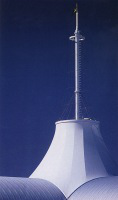
Goolwa State Heritage Area
There is a downloadable brochure titled Goolwa State Heritage Area (type "Goolwa State Heritage Area" into Google and follow the PDF download at http://www.environment.sa.gov.au/files/124b9692-92a8.../goolwa_sha.pdf) which draws a line around the centre of the town, defines it as a State Heritage Area, and lists a total of 17 buildings and locations. It includes: (1) the Council Chambers in Cadell Street which incorporate the original Town Hall (1860) and which were modernised in 1878 and 1907; (2) the Goolwa Hotel in Cadell Street which dates from 1853 and has the figurehead from the Irish sailing ship, Mozambique out the front; (3) the bow-fronted shop across from the hotel which dates from the 1850s and the early days of the river trade; (4) the Old Police Station and Court House in Goolwa Terrace which was built between 1859-74; (5) the morgue with government facility built in 1883; (6) the Post Office (built in 1857 and used by tramway passengers until 1872) in Goolwa Terrace opposite the Gardens in the middle of town which were completed in 1917; (7) the former railway horse stables behind the Post Office where the horses that pulled the train from Goolwa to Port Elliot were stabled (built 1862) - the horses were replaced by locomotives in 1884; (8) the former Railway Superintendant's house dating from 1852, known as the Round House it is the oldest building in town; (9) the railway cutting behind the post office which dates from 1852 and is the oldest surviving railway works in Australia; (12) the Corio and former Australasian Hotels on the corner opposite the post office (both these buildings date from 1857 when the town was at its height - the Australasian closed in 1934 and was used as an office for the building of the Goolwa barrage until 1940); and, closer to the river, (13) the Customs House (1859) which was built when Goolwa was proclaimed a port. The wharf (14) was built in 1852, extended in 1866, rebuilt in 1874 and extended in 1878 and the railway goods shed (15) was constructed in 1879 and relocated in 1913. The cottages in Little Scotland (16) at the end of Hayes Street were built in the 1860s and (17) Cockenzie House on Admiral Terrace which was built by Captain George Johnson in 1856.
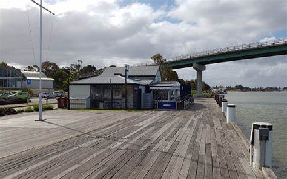
National Trust Museum
The town's National Trust Museum is housed in a blacksmith's shop which was built around 1872 and is located at 11 Porter Street. The museum's exhibits offer an insight into the history of the Goolwa and Hindmarsh Island focussing on the life of local Ngarrindjeri Aborigines before the arrival of Europeans, the town's shipbuilding industry and the local community. It is located on Porter Street and open from 2.00 pm - 4.00 pm Monday to Thursday, Saturday and Sunday, tel: (08) 8555 2221 or check out http://www.nationaltrust.org.au/sa/goolwa-museum.
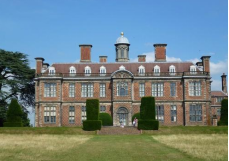
The Cockle Train
The Cockle Train, a superb old steam train, travels along the oldest steel-railed railway in Australia which dates back to 1887. It was constructed to provide a link between the Goolwa and the ocean wharfs at Port Elliot and later at Victor Harbor. The train runs at different times during the year but, typically, offers three return trips between Goolwa (where it is stationed) and Victor Harbor on Sundays and Wednesdays. It travels via Middleton and Port Elliot. The journey takes 30 minutes thus the 10.00 am from Goolwa reached Victor Harbour at 10.30 and returns at 11.00 am. There is a very useful and detailed website at http://www.steamrangerheritagerailway.org which provides information about timetables and costs. Bookings are essential. Tel: 1300 655 991.
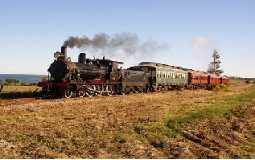
The Barrages
The problem with the Murray River is that it is 2,530 km long but it is so meandering and flat that saltwater, particularly on high tides, can literally reach hundreds of kilometres inland. Historically sharks were sighted over 200 kilometres upstream from Lake Alexandrina and dolphins were seen swimming in the river over 100 km from the mouth. It was not uncommon for the river to be saline up to 250 km from Lake Alexandrina. Consequently in 1931 it was decided to construct five barrages to separate the saltwater from the freshwater so that the fresh water quality could be improved and Adelaide, which relied on water from the Murray, could be provided with regular fresh water. The work on the barrages occurred between 1935-1940 with the main Goolwa Barrage taking the longest time. It is possible to travel through the Goolwa Barrage on the Spirit of Coorong cruises. On the way out to the Goolwa Barrage there is a Bird Watching Hide and the Goolwa Barrage is open to visitors from 8.00 am - 5.30 pm. For a detailed history check out http://www.mdba.gov.au/what-we-do/managing-rivers/river-murray-system/dams-weirs/the-barrages which explains the barrages in much greater detail.
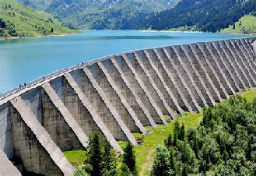
Hindmarsh Island
The appeal of Hindmarsh Island is the access it provides to the area of Lake Alexandrina across from the mouth of the Murray River. It is possible to reach the southern tip of the island and to view the sandbars which have made the mouth of the river so difficult for shipping. The island was the traditional home of the local Ngarrindjeri Aborigines and there is evidence of shell middens and very early occupation. It also offers an opportunity to see how a wilderness island can be turned into an upmarket marina by developers determined, and greatly assisted by politicians, to exploit what should have remained a peaceful wilderness for weekend anglers and bird watchers.
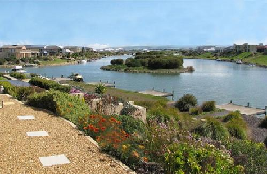
Cruises to the Mouth of the Murray and the Coorong
The Spirit of the Coorong, a comfortable 14-metre flat-bottomed boat, has a full cruise schedule of two major cruises around the Coorong National Park. On the shorter Coorong Discovery Cruise it departs from the main wharf at Goolwa, passes through the barrage which separates the ocean’s saltwater from the Murray River’s freshwater, passes the mouth of the Murray and heads down into the Coorong. The cruise include lunch, afternoon tea and a very informative commentary focussing on both the history of the area and offering a wide ranging discussion of the local flora and fauna. Expect to see many of the region’s 200 bird species including black swans and, of course, hundreds of pelicans. The Coorong Discovery Cruise lasts 4 hours (noon-4.00 pm) and operates on Thursday all year and Monday from October to May. Check out http://coorongcruises.com.au/soc/?page_id=74 for rates and further information.
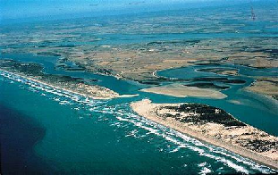
There is a longer tour: the Coorong Adventure Cruise which lasts 6 hours (10.00 am - 4.00 pm). It passes the mouth of the Murray, continues down Younghusband Peninsula where, at Godfrey’s Landing, passengers alight and cross the narrow peninsula, walk down onto the beach and search for cockles along the shoreline. Check http://coorongcruises.com.au/soc/?page_id=76 for more details.
There is also the Spirit II, 13.6 metres, seating 32 passengers, which departs at 1.30 pm on Saturdays between October and April and cruises through the barrage and down to the mouth of the Murray River where, if conditions are right, passengers alight and walk on the sandbar. Check http://coorongcruises.com.au/soc/?page_id=106 for more details or phone 1800 442 203 or (08) 8555 2203.
PS Oscar W Cruises
There is a one hour cruise on the PS Oscar W which departs from Goolwa Wharf at 11.00 am usually on a Saturday or Sunday once a month. There is a schedule of dates of departure at the website - check out http://www.oscar-w.info/cruises.html. It is a rare opportunity to travel on a genuine, historic paddle steamer. The Oscar W was built in 1908 by Franz Oscar Wallin at Echuca and has worked on the Murray, Murrumbidgee and Lake Alexandrina ever since. It is now over 100 years old and a trip on the paddle steamer is a reminder of the importance of the river trade prior to the arrival of the railways.
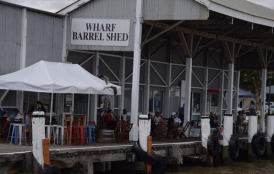
Other Attractions in the Area
The Sad and Complex Story of Hindmarsh Island and the Bridge
Hindmarsh Island, a scrubby and desolate piece of land popular with anglers and people wanting to escape into the wilderness, is separated from Goolwa by the Goolwa Channel, a narrow stretch of water which, historically, was only accessible by cable ferry or private boat. Not surprisingly this meant that on weekends in summer people planning to cross the channel had to wait for hours for the solitary ferry.
In 1977 two Adelaide developers, Tom and Wendy Chapman, purchased 30 hectares on Hindmarsh Island with a plan to turn a section of the sandy island into a 560 berth marina, build lots of expensive holiday housing and a golf course. To make their investment viable and profitable they proposed removing the ferry and building a bridge.
From the outset the development was fraught with problems (if you want to read every gory detail Wikipedia is particularly good - check out http://en.wikipedia.org/wiki/Hindmarsh_Island_bridge_controversy). Local people eager to retain the isolation of the island objected. People who wanted the island's quiet ambience retained objected and, most importantly, the local Ngarrindjeri people objected. They claimed that the island contained many sacred sites, was their land (it was – they could demonstrate continuous settlement of the area) and that any bridge would interfere with sacred sites.
In 1994 the complex issue of building a bridge was further complicated when a group of Ngarrindjeri women claimed that Hindmarsh Island was sacred to them and they could not discuss the issue because it was "secret women's business." Then things turned ugly. The Labour Minister for Aboriginal Affairs, Robert Tickner, put a 25 year ban on the building of the bridge. He had not seen the "secret women's business" but knew the rough outlines of the controversy. Then the Liberal Shadow Minister for the Environment tabled the secret documents in parliament. He was forced to resign but, by then, the secret documents had been photocopied and widely circulated.
The developers, the Chapmans, nearly went broke. The project looked like it was not going to go ahead and the complex issue of “secret women’s business” (hardly a new concept for anyone who knew anything about Aboriginal culture but a new concept to those ignorant of Aboriginal ways) ensured that the building of the bridge became a national issue. In 1995 a Royal Commission was established. It argued, without evidence, that the secret women's business was a fabrication. By 1996 the government had changed and the the conservative Howard government had come to power. In 1997 it legislated to allow the bridge to be built. The bridge was duly built although in 2010 the South Australian government did concede that the claim of secret women's business was genuine.
Aboriginal Canoe Tree
The Ngarrindjeri people who lived on the shores of Lake Alexandrina and down into the Coorong were largely sedentary due to the rich supplies of food offered by the lake and the ocean. Consequently their impact on the local area is very evident with large numbers of middens (piles of discarded shells) and canoe trees. A canoe tree can be easily identified because it is clear that the removal of bark and timber has left scars on the trees and branches. The Aboriginal Canoe Tree at Currency Creek is clearly signposted on the road between Goolwa and Strathalbyn. The length of the tree's scar, five metres, indicates that a vessel capable of carrying quite a crew was cut from its bark. It is a reminder of the rich heritage of the Ngarrindjeri in the area.
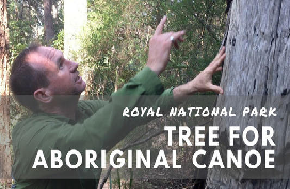
Clayton
Although only a few kilometres across Lake Alexandrina to the east of Goolwa, Clayton is 46 km by road via Milang. It is worth visiting as it offers another perspective on the lake and is wonderfully quiet and peaceful.
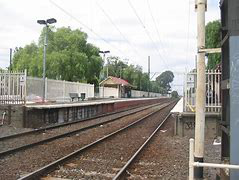
The Encounter Bikeway
There is a shared walkway (shared by cyclists, walkers, skaters and wheelchairs) which runs from Goolwa to Victor Harbour. Details and information about the track can be accessed at http://www.walkingsa.org.au/walk/find-a-place-to-walk/encounter-bikeway-shared-path.
https://www.aussietowns.com.au/town/goolwa-sa
VI. History and Culture
Origin of Name
It is widely accepted that "goolwa" is a Ngarrindjeri word meaning "elbow". It is located at an elbow on the Murray River.
History
Prior to the arrival of Europeans the area around Lake Alexandrina and through the Coorong had been the home of the Ngarrindjeri people.
By the 1820s whalers and sealers were operating in the area.
In 1829-1830 the explorer Charles Sturt travelled down the Murray River and reached the mouth at Lake Alexandrina..
In 1837 Colonel William Light inspected the area around the mouth of the Murray. He was not impressed seeing the land as poor and the mouth of the river as probably not navigable.
Goolwa was surveyed in 1840. A town was planned for Currency Creek.
In 1850 a police station was built at Goolwa. It closed a year later.
In 1851 a railway was built between Port Elliot and Goolwa at a cost of £20,000.
A jetty was built at Goolwa in 1852.
By 1853 paddle steamers were operating on the Murray. The first two steamers were the Mary Ann captained by William Randell and the Lady Augusta captained by Francis Cadell. Both travelled up river from Goolwa to Swan Hill.
In 1853 Goolwa started building boats to ply the Murray and Darling Rivers.
Goolwa was resurveyed in 1853 and blocks were sold for around £20. That same year a road was constructed between Goolwa and Port Elliot.
The railway between Goolwa and Port Elliot wasn't completed until 1854 and the cost blew out to £31,000. The trains carrying the goods travelled at about 10 km/h and had to be unloaded before the goods could be moved to the ships because the waters at Port Elliot were too shallow and the jetty was not long enough. After a decade in which no fewer than seven ships were wrecked off the coast, the port was moved to Victor Harbor. Goolwa became the last point for shipping on the river and then goods would be transported across to Port Elliot for export.
In 1857 it was officially proclaimed a port (the first inland port in Australia) and, with the construction of wharves and stores, it grew quickly servicing the vast inland of western New South Wales and Queensland. A regular paddle steamer service was established between Goolwa and Port Adelaide. The Goolwa Post and Telegraph Office was opened.
In 1858 a public ferry was established to ferry goods and people across to Hindmarsh Island.
By 1860 there was a road connecting Adelaide to Goolwa.
In 1864 a shipbuilding and repair works was established at Goolwa.
In 1872 Goolwa was gazetted as a municipality. A new railway station was built.
By 1878 the Morgan to Port Adelaide railway had been built.
By the 1880s about 25,000 bales of wool per year were being brought down the Murray and passing through Goolwa.
By 1913, when it stopped operating as a ship building port, Goolwa had seen 61 river boats built.
The Goolwa Barrages (there were five in total) were completed in 1940 at a cost of £700,000.
In 1977 Adelaide developers, Tom and Wendy Chapman, purchased 30 ha of land on Hindmarsh Island with plans to turn it into a marina with holiday housing and a golf course.
In 1981 the mouth of the Murray River closed for the first time in recorded history.
By 1987 parts of Goolwa had been declared a State Heritage Area.
In 2001 the Hindmarsh Island bridge was opened.
In 2002 the mouth of the Murray River was closed to the public and sand pumping began to try and open the river mouth.
In 2008-2009 the water in the Goolwa Channel dropped so dramatically that many vessels in the Goolwa Marina left the area.
In 2009 the Clayton Regulator was created to try and increase water in the Goolwa Channel and the Goolwa Marina.
https://www.aussietowns.com.au/town/goolwa-sa
Goolwa - Culture and History
The area of South Australia which now stretches from Lake Alexandrina and the mouth of the Murray River around through Goolwa to Port Elliot developed as a unified whole. By 1829 Captain Charles Sturt had made his historic journey down the Murray River and there was a feeling that a settlement should be established near the mouth of the river so that the inland could be opened up.
Fleurieu Peninsula travel guide
In 1837 Colonel William Light, responding to this interest, inspected the area around the mouth of the Murray and concluded that the land was poor and the mouth of the river was probably not navigable. The following year Sturt endorsed Light's view that the mouth of the Murray could not be made safe for navigation. This led to the establishment of Adelaide on Gulf St Vincent but there was still a body of support for the utilisation of the Murray River and a number of proposals (most involving safer harbours and moving goods overland to points further up the river) were suggested.
Eventually a decision was made that Goolwa would become the last point for shipping on the Murray River (it was located on the last bend before the river entered the sea) and there was a debate as to whether Victor Harbour or Port Elliot would be the ocean port. It was eventually decided that Port Elliot was the best location but this was probably based on its proximity to Goolwa and the belief that a canal could be constructed between the two locations. In 1851 it was agreed to build a railway between Port Elliot and Goolwa at a cost of £20,000. It ended up costing £31,000 and wasn't completed until 1854. It was, by any conventional measure, a bit of a disaster. It rarely made a profit and the trains carrying the goods travelled at about 10 km/h and had to be unloaded before the goods could be moved to the ships because the waters at Port Elliot were too shallow and the jetty was not long enough. After a decade in which no fewer than seven ships were wrecked off the coast, the port was moved to Victor Harbor.
By 1853 paddle steamers were operating on the Murray. The first two steamers were the 'Mary Ann' captained by William Randell and the 'Lady Augusta' captained by Francis Cadell. Both left from Goolwa and travelled up river as far as Swan Hill.
The town of Goolwa had been surveyed as early as 1840 but it was resurveyed in 1853 and blocks were sold for around £20. That same year a road was constructed between Goolwa and Port Elliot and by 1860 there was a road over the hills to Adelaide. In 1857 it was officially proclaimed a port (the first inland port in Australia) and, with the construction of wharves and stores, it grew quickly servicing the vast inland of western New South Wales and Queensland. At its peak in the 1880s about 25 000 bales of wool per year were passing through the port. A decade later, because the railway had taken away most of the business which had previously operated on the river, Goolwa's importance as a port had all but disappeared.
The Goolwa Barrage was completed in 1940 at a cost of £700,000.
https://www.traveller.com.au/goolwa--culture-and-history-6bc9
VII. Contact Information
Mayor Keith Parkes
Position
Mayor
Contact
08 85557000
keith.parkes@alexandrina.sa.gov.au
0408 818 663 (Mobile)
https://www.alexandrina.sa.gov.au/council/elected-members/contacts/parkes,-keith
Council Contact Details
Phone: (08) 8555 7000
Fax: (08) 8555 3603
Email: alex@alexandrina.sa.gov.au
Post: PO Box 21 Goolwa SA 5214
https://www.alexandrina.sa.gov.au/contact
